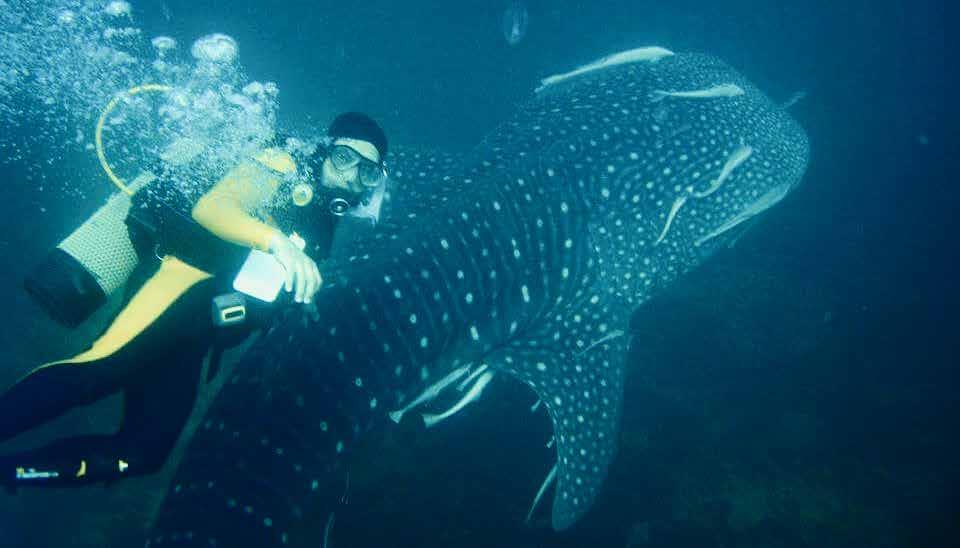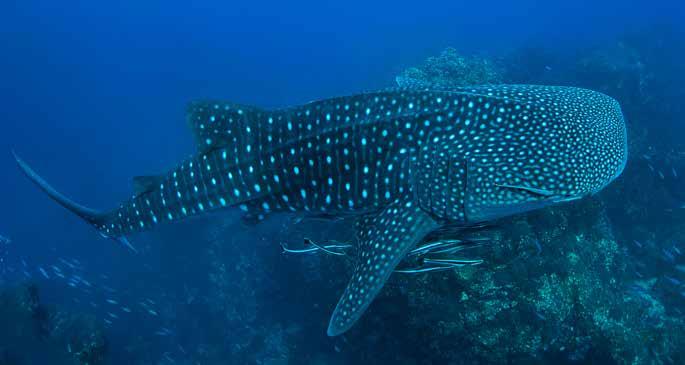Fish finders
Aramco’s offshore facilities attract whale sharks, open doors to potential tourism venue

Global October 01, 2017 - By
Sharks are circling on the horizon off Aramco facilities. Big sharks, and that’s a good thing.
A KFUPM shark study team, part of the broader Aramco-KFUPM Marine Sustaining Research Program, spotted whale shark aggregations around several of Aramco’s offshore facilities about 100 km off Jubail in 2017. The world’s biggest fish, the whale shark is a harmless animal and friendly when interacting with humans, thus its nickname “the gentle giant of the sea.” Because of its temperate character that complements its beautiful white strips and spots cascading alongside its huge body that entice divers, many countries have developed whale shark ecotourism, where tourists can swim alongside these majestic species and even catch a ride on their fins. This educational tourism venue has great potential for the Kingdom in the near future and aligns with broader tourism strategies outlined in the broader Saudi Vision 2030 economic diversification program.
Gentle giant of the sea
Huge as whales, hence their name, whale sharks (Rhincodon typus) are born at around 65 cm in total length and grow as large as 18 meters as adults. At present, there are 23 shark species in the Arabian Gulf alone, and unlike other predatory sharks off Saudi coasts, the whale shark has no sharp teeth — it is one of three filterfeeding shark species, which swallow hundreds of tons of seawater to filter tiny planktonic prey every day. There population structure and gathering period in Saudi waters are still under investigation, and further research and continuous monitoring are underway.

Shark stories
Many people still conjure up images of sharks from the 1975 thriller movie “Jaws,” with a ferocious image of a bloodthirsty shark terrorizing resort towns deeply implanted in their minds. However, the main character in that movie, the great white shark (Carcharodon carcharias), is just one species of shark—one of many. Actually, there are more than 500 living species of shark in the world today. Sharks have existed in the world’s oceans for more than 400 million years. Most of them are top predators in various marine ecosystems and are important regulators that help to manage healthy marine ecosystems. That is to say, the higher the shark biomass and diversity, the healthier the marine ecosystem.
Sharks in the Arabian Gulf
Saudi Arabia is home to the longest coastline along the Arabian Gulf and with many diverse habitats, but reports of sharks in Saudi waters are rare. Therefore, Aramco supported the “Sustaining Project-Shark Study” launched by scientific researchers to study sharks beginning in 2016. During the one-year investigation, exciting results revealed that there were at least 23 shark species observed and recorded, more than the team had expected, and the species richness (i.e., the number of species, with higher species richness meaning more species are identified and recorded) is still increasing by month.
The team recorded the small oviparous Arabian bamboo shark Chiloscyllium arabicum with a maximum length of 80 cm and the zebra shark Stegostoma fasciatum, which has zebra-like stripes in juvenile stages and a leopard-like spot pattern as an adult. Researchers also documented one of the most dangerous shark species, the bull shark Carcharhinus leucas, which can travel 4,000 km up freshwater rivers and has been attributed to many recorded attacks on human beings.



